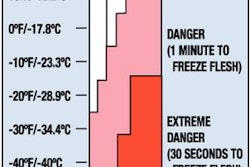
Each year about now we publish advice on how to work outdoors in the cold months and stay comfortable and productive. We are continually learning new things about this topic and it helps to stay abreast of the Best Industry Practices.
We have also learned the hard way that climate change is already making a difference in how we work. Severe weather events that were more or less manageable just a few years ago, will now put a conclusive stop to, or at least a major delay, in our operations. No amount of cold weather clothing is going to help when there are feet of snow falling and the temps are in single digits. That’s called ‘Snowmageddon’ and we need to plan for it.
El Nino, the character most responsible for winter precipitation intensity, is predicted to be the strongest ever recorded this winter, if that gives you a clue. In other words, this doesn’t look like Kansas anymore. We will all probably be learning some hard lessons, so keep reading.
At least the accuracy of weather forecasting has been improving. This allows you to pick out the right wardrobe from your dry cleaner the night before.
Garment engineers and textile designers have been working overtime to come up with some interesting new materials. A lot of innovations have come from the sport and recreational apparel sectors, so look over the traditional horizon, particularly if your exposures are in the extreme category, such as oil & gas, mining, tower maintenance, etc.
Because most of our core body heat is in the torso region, this is where layered protection is most important. The head and neck are where we lose the most body heat, so it’s really a balancing act to stay warm, stay comfortable and still be able to move around.
Here are some of the major food groups:
Raingear: depending on your work profile, select the most user friendly garments available.
- Rain suits are one option, bib style pants and jacket with hood. This is a fairly common and very effective assembly, but it can also be uncomfortable under all that vinyl. The garments worn beneath the rain suit should be light and breathable, such as cotton and wool blends. It is a little cumbersome to manage this gear in extreme cold. But then again, it’s not going to be raining in extreme cold.
- Duster-style long raincoats are also very good for rain protection, with the added features of breathability and range of motion, due to their open front. When coupled with high top rubber boots, this is a good option for staying dry. Size up to allow insulating garments beneath.
Cold / Wind Exposure: if you’re out on the range, you need to be thinking of dressing in several light LAYERS of fabric:
- The outermost layer should be lightweight and wind resistant.
- Best Practice is to incorporate high visibility and reflective striping into this outer layer, thus avoiding the need for adding a vest. Avoid camo. patterned clothing.
- Insulated coveralls – relatively expensive and less than optimal agility, but in a lot of long duration, cold exposures, they are the best option
- A close cousin are insulated bib overalls. At least with the bibs your upper body movement is still fairly good. These garment are effective at retaining core body heat because they minimize the openings for heat loss.
- Thermal long johns – basically any cotton weave in a waffle pattern next to the skin will help trap body heat.
- Quilted fabrics for upper body covering, good. Flannel, good
- Fleece fabrics, good. Wool, other natural fibers, usually good
- Leather, not so good
- Vinyl, polyester, other synthetics, usually poor for insulating
- Insulated vests, very good
- Hoodies, very good. Fleece lined zippered front hoodies, fantastic.
- Long-tail tees and shirts are preferred. Usually found on higher quality garments.
- Lots of pockets. Fantastic.
- If you have the option, look for button as well as zipper or Velcro closures on upper body garments. You may pay a bit more for this. Buttons allow adjustment for cooling. Zippers and Velcro allow complete closure to block heat loss.
Other cold weather tips
- Avoid breathing cold air directly. Use a dust mask with exhalation valve or scarf over your nose/mouth. All that vapor you are exhaling is moisture loss from your body. See: Hydration, below. Cold air can irritate upper respiratory tract. Chew sugarless gum. Cut down or quit smoking.
- Select the correct glove configuration for the task. Dexterity, insulating properties, grip surface characteristics, impermeability, liners and inserts, etc. The glove industry has come a long way, do the research with a good PPE supplier, you’d be surprised what’s out there.
- Wear eye/face protection. Wrap-around glasses are universally applicable in cold weather, because they protect the exposed area around the eyes, which have a lot of blood flow, and therefore heat loss. In addition, the eye is a mucous membrane, subject to dehydration. The eye and nose are prime vectors for flu virus entry to the body. Proper hydration and a little bit of protection can go a long way here.
o Severe cold/wind exposures: consider ski goggles or other protective enclosure. Yes, they may fog up. Buy the anti-fog coating or a bottle of spray on de-fogger. Or keep a spare pair of goggles handy at ambient temperature to swap out.
o Hard hat mounted face shield, full or half visor might also be an option, depending on the job. These visors are also available in tinted shades, so on a bright sunny, windy day, they might offer some help. Let your Safety Committee do the research.
o In other words, protect your eyes from direct cold/wind exposure
- Headgear: most of us have to wear hard hats. Wide brim hats are generally recommended for outdoor work, mostly because the brim can act as a wind deflector and glare shield. Whichever hat you use, select a helmet liner to turn it into a comfortable assembly. Flannel/cotton liners are among the most common. Fleece lined, full head and neck liners are probably the warmest combination. Protecting the head and neck from heat loss is an important element in staying warm, so pay attention to it.
o Liners also help keep the hat in place on the head, allowing less compression on the helmet suspension.
- Select the best footwear for your exposure.
o Steel toes will absorb cold. Composite toe caps can help.
o Avoid direct standing on frozen earth. Boots get wet, change them out or you shiver all day.
o Up size your boots to allow for another layer of socks or use two medium layers.
o Use insole inserts, for insulation, comfort, stability. Digital sole and arch geometry measurements can help you select the best boot liner, which will improve your gait, posture and lessen fatigue
- Extreme exposures: provide a warm place for breaks and possibly a changes of socks and gloves as needed.
- Do some warm up exercises before starting work. Even climbing into the cab of a machine is a little bit of a workout, so limber up in advance. This helps to circulate warm blood to oxygenate muscle mass.
- Stay hydrated year ‘round. Surprisingly enough, proper hydration helps you stay warm. Remember, our blood will thicken in cold weather. Proper hydration allows better circulation, respiration, digestion and a host of other body function to proceed. Not to mention, proper hydration is important for the body’s cold and flu avoidance defenses.
- Use barrier crème on exposed skin. This stuff is almost like a coat of paint. Helps protect against a range of exposures. Washes off with soap and water.
- Hand crème: cold air is usually dry. Chapped skin can be a real nuisance. Re-apply after hand washing. Work it into fingers and cuticles.
- Long duration cold exposures in remote areas:
o Review your first aid tutorial for treatment of frost bite/hypothermia
o Have portable heaters available
o Use extreme caution around open flame, hot work, welding, campfires, etc. particularly when wearing insulated clothing.
o If you are beyond 911 response areas, additional precautions will apply, well beyond the scope of this article.
Summary: who would have guessed that we would cover industrial hygiene, climatology, chemistry, biology and high fashion all in one technical article?!! The moral of the story is that if you truly expect to protect your people, you need to be taking a much wider perspective than simply buying heavier winter coats. Our changing climate will soon make this very clear. Incidentally, the reverse of this article will appear in late spring when we look at high heat exposures. That should make for interesting reading!



















